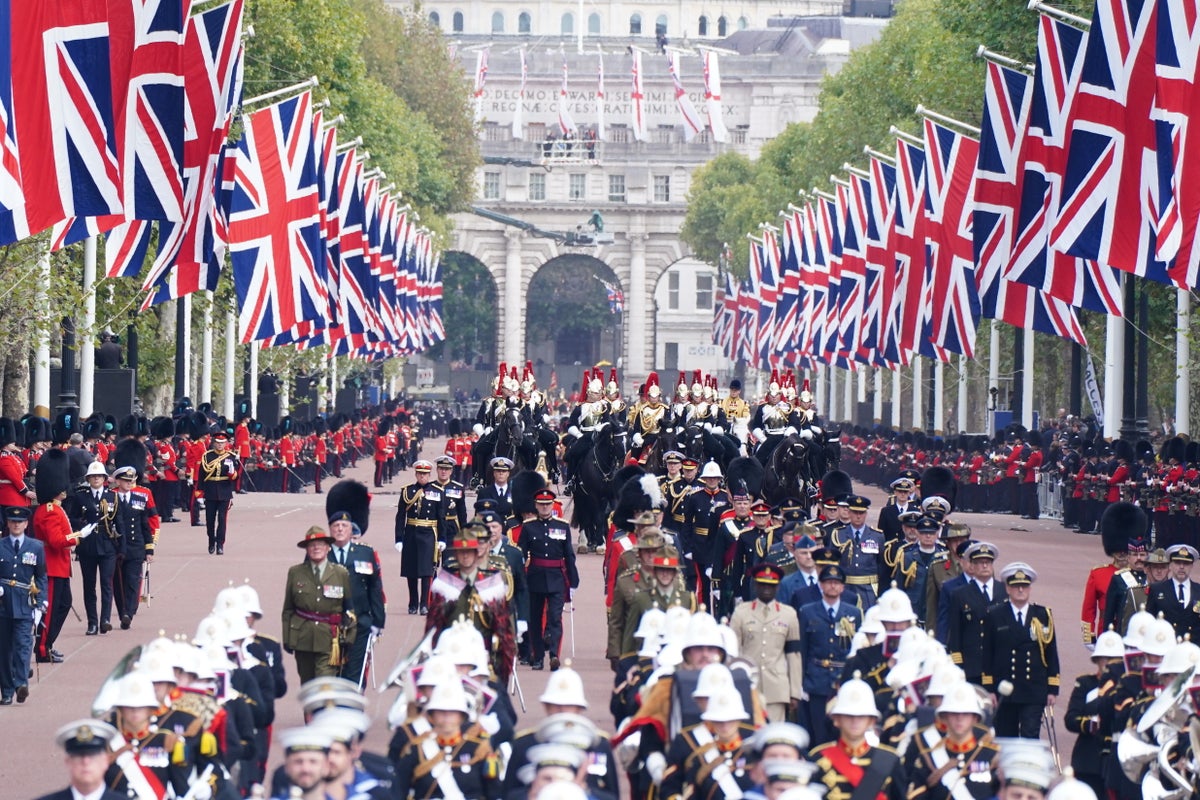
As the coffin went past, many couldn’t hold back tears, the reality of the day finally kicking in.
Thousands of mourners had been lining the streets for hours – some, in fact, for days – for the Queen’s funeral procession through London on Monday morning. And when the moment came – when she was pulled past them in an oak coffin on the state gun carriage of the Royal Navy by 142 sailors – they were unable to stop their emotions showing.

“I was crying buckets,” said Linda McQuaid, a 66-year-old nurse who had camped out on the Mall for two days to see the moment. “There were tissues being passed up and down the line, people holding each other, struck by it all. I still don’t think anyone could believe what they were seeing, that this was the last goodbye.”
Yet others found reason to be cheerful. The pomp and the pageantry was, they said, a celebration of all that was good about Britain. “You cannot feel too down for too long when you are witnessing something like that,” said Heather Savage, a 52-year-old hospital worker who had also camped out.
This was the country’s final farewell to Elizabeth II after 10 days of national mourning.
And while the Westminster Abbey service and the procession to Wellington Arch that followed lasted barely three hours, it will – the crowds here agreed – be talked about for centuries to come. This, one noted, is what witnessing history feels like.
It was sombre, yes, but spectacular too; both black-tie respectful yet also resplendent with reds and golds, blues and greens.

“It’s a privilege to have lived through her reign,” said one mourner, Fiona Bearcroft, a benefits worker who had travelled from Yeovil with her mother Doreen and daughter Eleanor to be here. “After years of service, it is the least we can do to come and pay our respect.”
Anticipation had been swelling in the capital since first light. Indeed, strictly speaking, it had been swelling since before that with thousands of people camping out on the Mall to ensure they got a front row view of proceedings.
The crowds built all morning. By 8am Westminster Bridge was all but unpassable, while Horse Guards Parade was pretty much at capacity. The multitudes jostled good-naturedly for space and queued patiently for coffees and toilets. As helicopters patrolled the skies – and the occasional diplomatic limousine drove through fenced-off roads – people spoke of feeling a compulsion to pay their last respects to the Queen.

But, for many, it was perhaps only when the broadcast of the service started playing on those loud speakers at 11am that the true enormity of the day really took hold. In Westminster, along Whitehall and the Mall, and in Hyde Park, silence fell. Heads were bowed – and seemed to stay that way throughout. When the Archbishop of Canterbury reminded the assembled listeners of the Queen’s pivotal role during the Covid-19 pandemic – her famous declaration that “we will meet again” – many in the crowd were already wobbling.
When the two-minute silence was called at 11.55am, one could have heard – save for the occasional baby cry – a pin drop.
And then – slowly, slowly, to the sound of distant gunfire being fired once a minute at Hyde Park – came that procession, from the abbey, up Whitehall, down the Mall and along Constitution Hill to Wellington Arch.

Its arrival could be heard before it was seen. The sounds of Beethoven and Mendelssohn – beaten out by some 200 military musicians – drifted up the Mall, like the sound of, well, a distant army getting closer. And then, led by a mounted unit from the Metropolitan Police and the red-jacketed Royal Canadian Mounted Police, the mile-long procession of 2,000 people came into view.
Army, navy and air force detachments marched past. Representatives of Commonwealth forces strode along. Gurkhas, George Cross recipients and members of the royal household were all present.

And then, a buzz of anticipation. Pulled on the state gun carriage by 142 sailors and gloriously draped in the royal standard, came the coffin itself. Atop was the imperial state crown, orb and sceptre. Several people threw flowers at it. Several more – inevitably – held mobiles. The press corp of photographers smashed their camera buttons.
Behind came the Queen’s four children – King Charles, Princess Anne, Prince Andrew and Prince Edward – and then her grandchildren, Prince William, Prince Harry and Peter Phillips. All looked crestfallen. Further to the rear were royal cars bearing the Princess of Wales and the Queen Consort. As they passed down the Mall, the sun broke from the morning’s grey clouds. Even the weather, it seemed, wanted to honour the moment. The imperial state crown glistened in the sun.
“So emotional,” said Hayley O’Hare, an account manager who had travelled down from Manchester with her sister and their children. “There were a lot of people around me with tears in their eyes, and I was close myself. It’s just so sad to think we won’t see her again.”
Yet the pomp and pageantry of the day – the sheer ceremonial might of the British state – was a reason for cheer, she said. “There are so few countries in the world who could organise something like this,” the 44-year-old reckoned. “That’s something to be proud of.”
The procession continued on to Wellington Arch, where the coffin was placed in the state hearse for the Queen’s final journey to Windsor.
There, a little more than 70 years after she ascended to the throne, she will be buried as Britain’s longest-serving monarch; her Elizabethan Age now part of the past – but never to be forgotten.







